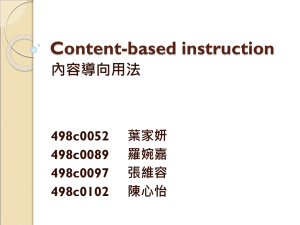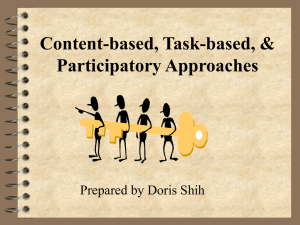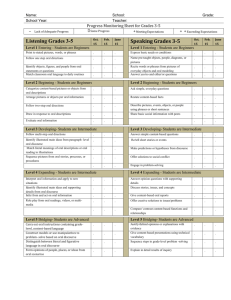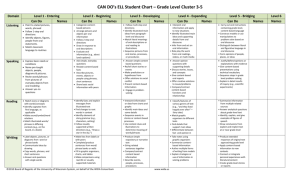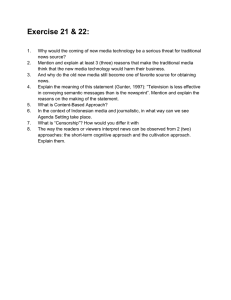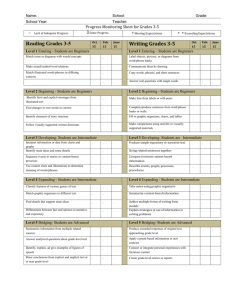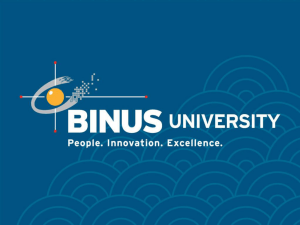Content-based approach 四技英語三甲 497c0040 鄭惠勻
advertisement
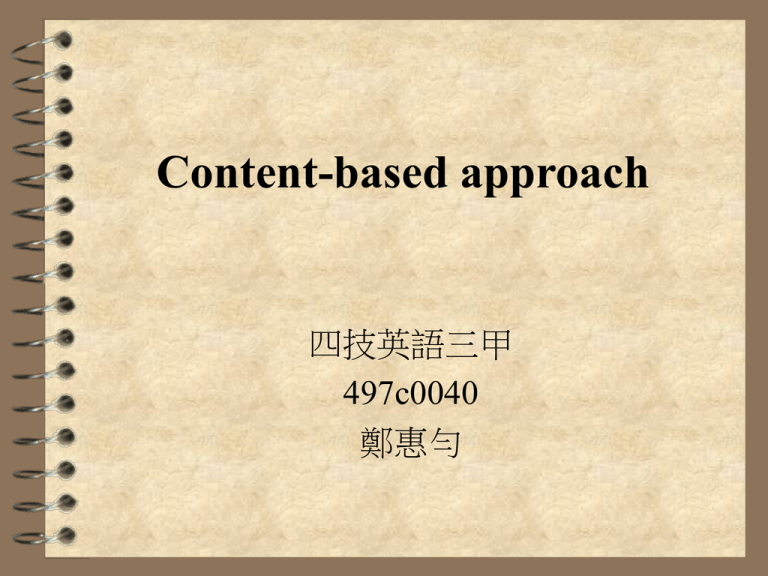
Content-based approach 四技英語三甲 497c0040 鄭惠勻 Outline for Today Content-based introduction Content-based instruction Content-based analyze Conclusion Introduction Content based instruction (CBI) is a teaching method that emphasizes learning about something rather than learning about language. 以知識性學科(content areas)做為第二語言上課的 內容,將學科內容整合於語言學習中,簡稱CBI。例如: 以英文來上數學、歷史、地理等課程。 Although CBI is not new, there has been an increased interest in it over the last ten years, particularly in the USA and Canada where it has proven very effective in ESL immersion programs. Introduction This interest has now spread to EFL classrooms around the world where teachers are discovering that their students like CBI and are excited to learn English this way. CBI課程內容大多是學校主要科目,但也可擴展至電影、 藝術、科學、建築等其它專業或學生較感興趣的科目。 內容本位語言教學的課程安排,通常必須由教授專業 科目的教師及語言教師共同研發討論。學科教師可先 將教學目標告訴語言教師,雙方再共同決定如何將學 科與語言學習融合於課程中。 Content-based Instruction (1) Use content from other disciplines in language teaching “Language across curriculum” movement started in England 1970 整合語言學習與其它內容(其它學科)的學習。 如學生不是用母語來學其它學科,就需要大量 的協助來理解學科內容。 語言和內容學習,目標都要設定清楚 Content-based Instruction (2) Build on students’ previous knowledge Students motivated to learn because of language is a tool for their purpose. Teacher help to scaffold linguistic content Language is learned best when used to deliver interesting information Vocabulary can be easily acquired with contextual cues Content-based Instruction (3) Teacher give examples to help students realize the content. Learners use authentic materials to practice language Communicative competence = able to read, discuss, write about content of other fields Scaffolding: Vocabulary activity Read the book The Giver by Lois Lowry Let the learners take a look at the book Pick out certain vocabularies/concepts Let student figure out how to act the words or paragraph Help students to build knowledge on words according to context Analyze The goals of teachers: give priority to process over predetermined linguistic content. The roles of the teachers: assist learners in understanding subject matter. The roles of the students: both study academic subject matters and learn a foreign language. Analyze The characteristics of the teaching/learning process: integrates the learning of language with the learning of some content, that is, academic subject matter. Language objectives are dictated by the texts. Students are engaged in purposeful use of language. The nature of student-teacher/student-student interaction: while completing the academic tasks in the foreign language, all interaction types are possible. Analyze The views of language and culture: since students have a purpose that is content, it is easier for them to master the target language. The language skills: all four skills The role of the students’ native language: there is no role of the native language. Evaluation: students are evaluated for the content they are learning. Conclusion The special contribution of content-based instruction is that it integrates the learning of language with the learning of some other content, often academic subject matter. CLT lesson centered on giving students opportunities to practice using the communicative function of making predictions. Conclusion 語言教學可採用其它的學科內容。 教學是建立在學生過去的經驗上。 當學生知道自己的語言有用處時,學習 動機就會提高。他們知道語言本身不是 目的,而是達到目的的工具。 老師提供語言內容的架構。 內容要引起學生興趣 Conclusion 單字配合著上下文,更容易傳達出語意, 利於學生學習單字。 學生學習真實的學科內容,需要語言的 協助。如給例句、重複練習。 學生利用真實教材、活動練習的語言與 內容。 溝通能力不只有口語對話,包括閱讀、 討論、寫作其它領域。 References http://iteslj.org/Articles/Davies-CBI.html http://www.carla.umn.edu/cobaltt/cbi.html ~The End~ ~Thanks for your listening~
